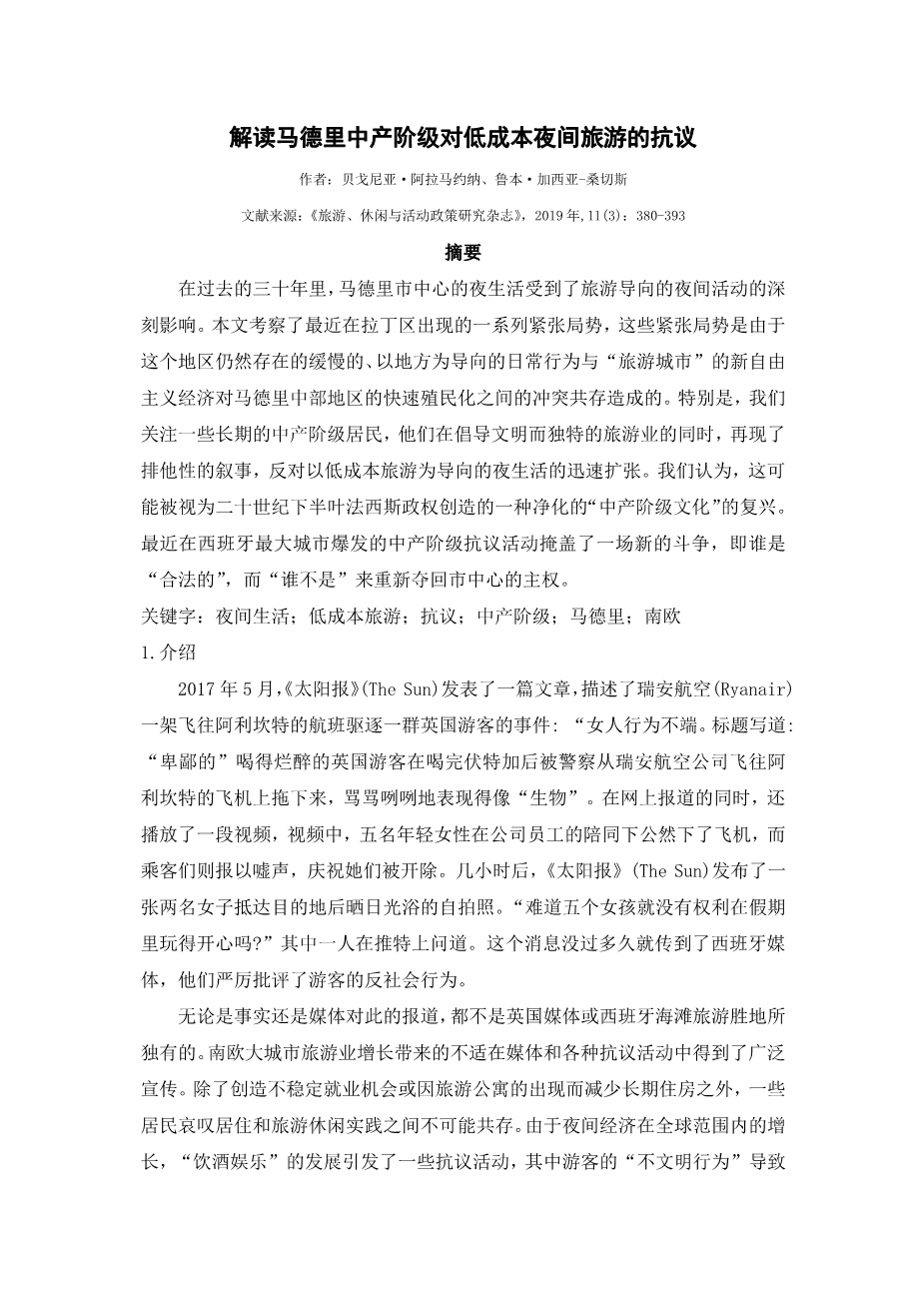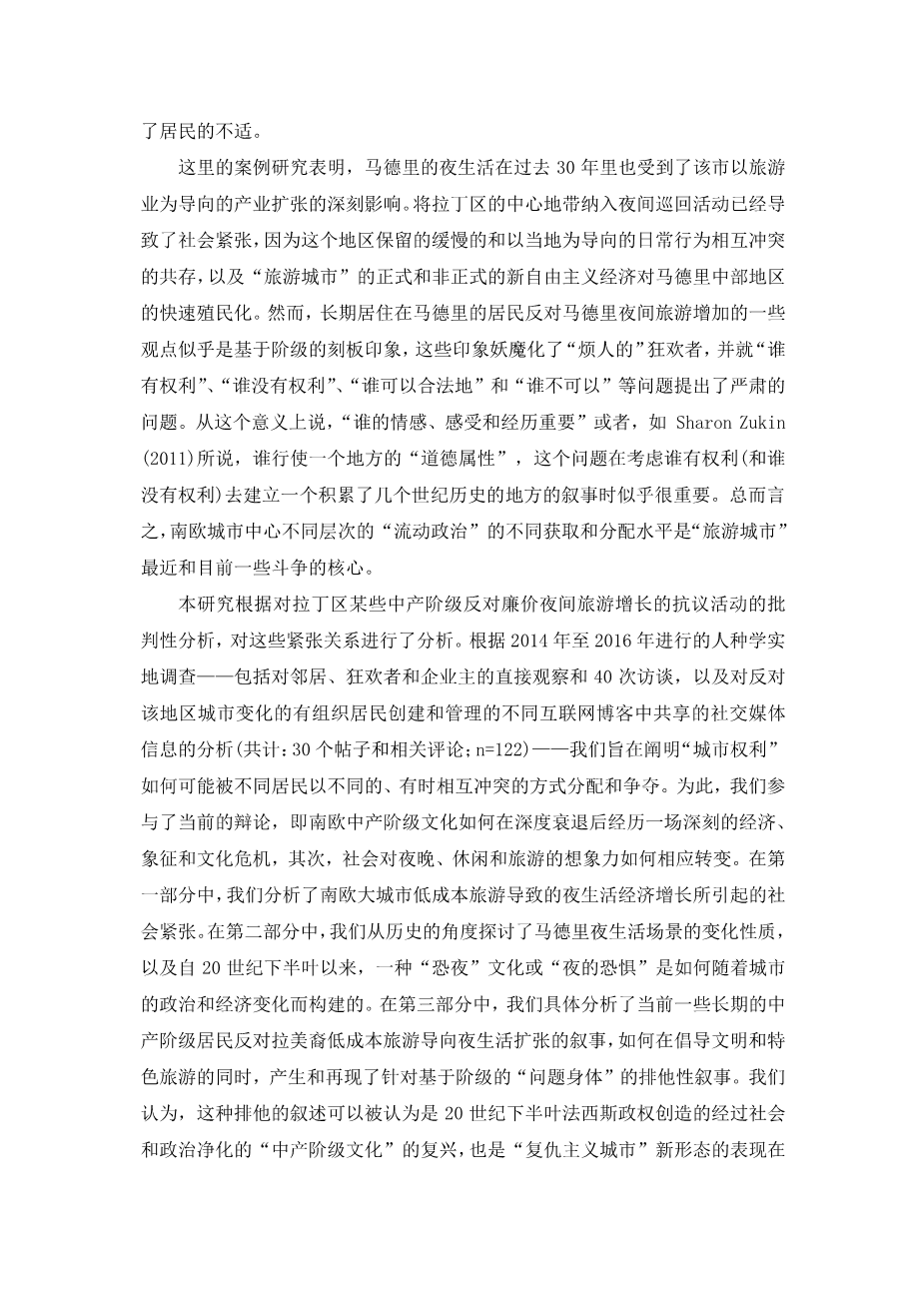解读马德里中产阶级对低成本夜间旅游的抗议外文翻译资料
2023-04-14 18:33:39
Decoding middle-class protest against low-cost nocturnal tourism in Madrid
Begontilde;a Aramayona Rubeacute;n Garciacute;a-Saacute;nchez
ABSTRACT
Nightlife scenes in central Madrid have been profoundly affected due to the expansion of tourist-oriented night-time leisure activities during the last three decades. This paper examines a range of tensions that have recently appeared in the La Latina neighbourhood due to the conflictual coexistence between the slow and locally-oriented everyday practices remaining in this territoir and the rapid colonisation of this central quarter of Madrid by neoliberal economies of the lsquo;Tourist Cityrsquo;. Particularly, we focus on some long-term, middle-class residents who reproduce exclusionary narratives against the rapid expansion of low cost tourist-oriented nightlife, while advocating a civilised and distinctive tourism. We argue this may be seen as a renaissance of a sanitised lsquo;middle-class culturersquo; created by the fascist regime in the second half of the twentieth century. Recent middle-classrsquo; protests in Spainrsquo;s largest cities hide a new struggle about lsquo;who is legitimisedrsquo; and lsquo;who notrsquo; to reclaim the re-appropriation of the city centre.
Keywords Nightlife; low-cost tourism; protest; middle classes; Madrid; South Europe
1.Introduction
In May 2017, The Sun newspaper published a piece describing the expulsion of a group of British tourists from a Ryanair flight to Alicante: lsquo;WOMEN BEHAVING BADLY. “Vile” boozed-up Brit tourists hauled off Ryanair flight to Alicante by cops after knocking back vodka, swearing and acting like “creatures”rsquo; read the title. The online report was accompanied by a video in which five young women defiantly exited the plane, escorted by company employees, while passengers booed and celebrated their expulsion. Hours later, The Sun published a selfie of the women sunbathing once they reached their destination. lsquo;Donrsquo;t five girls have the right to have a good time on holiday?rsquo; asked one of them on her Twitter. The news did not take long to reach the Spanish press, which harshly criticised the antisocial behaviour of the tourists.
Neither the facts, nor the media narrative about them, are exclusive to the British press or Spanish beach destinations. The discomfort resulting from the increase in tourism in large Southern European cities has been widely publicised both in the press and via protests of various kinds (Colomb amp; Novy, 2017; Sequera amp; Nofre, 2018). In addition to the generation of precarious employment (Hernaacute;ndez, 2016; Santana, 2000) or the reduction of long-term housing arising from the emergence of tourist apartments (Arias amp; Quaglieri, 2016; Coacute;cola, 2016), some residents lament the perceived impossibility of coexistence between residential and tourist leisure practices (Nofre et al., 2017a, 2017b). The development of lsquo;drinkatainmentrsquo; (Bell, 2007), resulting from the growth of the night-time economy (NTE) on a global scale, has triggered some of these protests, in which the visitorsrsquo; lsquo;uncivilised behaviourrsquo; contributes to the residentsrsquo; discomfort.
Madridrsquo;s nightlife, the case study examined here, has also been profoundly affected by the expansion of tourist-oriented industries in the city over the last three decades. The inclusion of the central neighbourhood of La Latina in the nocturnal circuit has led to social tensions due to the conflicting coexistence of the slow and locally-oriented everyday practices preserved in this territoir and the rapid colonisation of this central quarter of Madrid by formal and informal neoliberal economies of the lsquo;Tourist Cityrsquo; (Colomb amp; Novy, 2017). However, some of the arguments expressed by long-term residents against the increase in Madridrsquo;s nocturnal tourism seem to rely on class-based stereotypes that demonise the lsquo;annoyingrsquo; revellers and pose serious questions around lsquo;who has the rightrsquo; and lsquo;who notrsquo;, and lsquo;who can legitimatelyrsquo; and lsquo;who cannotrsquo; reclaim the city centre. In this sense, the question of lsquo;whose emotions, sensations and experiences matterrsquo; (Hadfield, 2014, p. 7) or, as Sharon Zukin (2011) states, who exercises the lsquo;moral propertyrsquo; of a place, seems important when considering who has the right (and who does not) to build the narrative of places that accumulate centuries of history. In sum, different levels of access and distribution of the lsquo;politics of mobilityrsquo; (Adey, 2006, Cresswell, 2010, Hall, 2005) in Southern European city centres are at the core of some of the recent and current struggles of the lsquo;Tourist Cityrsquo; (Colomb and Novy, 2017).
This study analyses these tensions in light of the critical analysis of certain middle-class protests against the growth of low-cost nocturnal tourism in La Latina. Based on ethnographic fieldwork conducted between 2014 and 2016 – which included direct observation and 40 interviews with neighbours, revellers and business owners, as well as the analysis of social media information shared in different internet blogs created and administered by organised residents opposed to urban changes in the area (in total: 30 posts and associated comments; N = 122) – we aim to shed light on how the lsquo;right to the cityrsquo; (Lefrebve, 1968) might be appropriated and contested in diverse and sometimes conflicting ways by different inhabitants. In doing this, we engage with current debates around how Southern European middle-class culture is experiencing a profound economic, symbolic and cultural crisis in the aftermath of a deep recession and, secondly, how the social imaginaries of the night, leisure and tourism have shifted accordingly. In the first section, we analyse the social tensions arising from the increase in nightlife economies resulting from low-cost tourism in large Southern European cities. Second, we explore the changing nature of Madridrsquo;s nightlife scene from an historical perspective, and how a lsquo;nyctophobicrsquo; culture (Edensor, 201
剩余内容已隐藏,支付完成后下载完整资料


英语译文共 11 页,剩余内容已隐藏,支付完成后下载完整资料
资料编号:[589390],资料为PDF文档或Word文档,PDF文档可免费转换为Word




